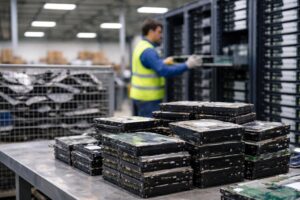The digital explosion is pushing data centers to their limits and making them find smart ways to handle information efficiently. Furthermore, conventional chip design faces several challenges with the industry pushing for smaller and more powerful computing solutions. These issues include limited space for components, heat dissipation that is not efficient and longer interconnect distances. However, 3D stacking has become a promising solution in recent years. It can revolutionize operations and majorly improve energy efficiency leading to cost savings and sustainability. So, let us dive deeper and learn more about 3D stacking for data center energy efficiency.
Transforming Data Center Energy Efficiency
3D chip stacking technology shows a positive impact on data centers and enables new opportunities for cost optimization. This section goes through the key ways in which the innovative approach transforms data center operations:
Increased Compute Density
3D chip stacking allows for a remarkable increase in compute density. So, this allows data centers to get up to 5 times more power for processing into the same physical footprint. Furthermore, the vertical integration of components not only maximizes the utilization of space but also reduces the need for expensive expansion of real estate. Moreover, studies show that 3D chip-equipped data centers can get a 4x improvement in performance per watt. This allows companies to handle the growing data workloads without stressing over increasing the facility size or energy consumption.
Improved Cooling Efficiency
3D chip stacking shows incredible thermal management capabilities that revolutionize the cooling systems of data centers. Furthermore, the chips dissipate heat up to 3 times more effective when compared with traditional designs. This is because they have advanced through silicon vias and microchannel liquid cooling techniques. So, this breakthrough allows the data centers to reduce their infrastructure for cooling by up to 40 percent. This, in turn, leads to major energy savings and a smaller environmental footprint. So this reflects the impact of 3D chip technology on data center energy consumption
Accelerated AI and Machine Learning Capabilities
3D chip stacking reflects a unique architecture that gives a great boost to AI and machine learning capabilities in data centers. Furthermore, this technology can give 10 times faster AI inference and training performance. This is done by integrating the specialized AI accelerators and tensor processing units directly into the chip stack. As a result, this acceleration will allow data centers to handle complex AI workloads with perfect efficiency. Moreover, it will reduce energy consumption and time in need for AI computations majorly when seen with traditional GPU-based solutions.
3D Chip Stacking: Overcoming Challenges and Barriers
The benefits of 3D chip stacking are substantial. However, there are some challenges or barriers that need focus for widespread adoption in data centers. This section delves into some of the key issues that data center operators must overcome for successful implementation.
Manufacturing Complexity
One of the major challenges that comes with the implementation is the increased complexity that manufacturing 3D chip stacks hold. Furthermore, the process requires advanced techniques of fabrication and specialized equipment. This can lead to higher costs of production and potential yield issues. Moreover, overcoming this challenge is important for making 3D chip stacking a cost-effective and scalable solution that can come in use widely for data centers.
Integration with Existing Infrastructure
Integration of 3D chip stacking into the existing data center infrastructure can be challenging as well. Furthermore, making sure of compatibility with current hardware, software, and cooling systems can demand major investments and adaptations. So, this can slow down the process for adoption. Moreover, data center operators should carefully see the feasibility of upgrading their infrastructure to accommodate 3D chip stacking and make sure of a smooth transition that minimizes disruptions to ongoing operation
Testing and Quality Assurance
The multi-layered nature that 3D chip stacks show introduces new complexities in testing and quality assurance. Furthermore, traditional testing methods may not be sufficient to detect defects or issues in performance in deeply integrated chip layers. So, making comprehensive strategies for testing that can effectively evaluate each layer and the stack in its entirety is essential. This can involve creating new equipment for testing, new methodologies, and software tools that are specially designed for its architecture. Making a thorough quality control is extremely important for building confidence in the reliability and performance of the technology particularly in data center applications. This is because uptime and dependability are crucial pillars of it.
Future Innovations in 3D Chip Stacking
As the industry continues to address the challenges that 3D chip stacking brings, several innovations are emerging. These can enhance the impact of the technology on the data center’s energy efficiency. This section explores some of the key advancements seen that are set to drive 3D chip stacking.
Self-Healing Architectures
There is a lot of research going into self-healing capabilities for 3D chip stacks. This is to improve reliability and reduce maintenance-related energy waste. Furthermore, with the inclusion of redundant circuits and AI-driven fault detection systems, these chips can automatically reroute signals around damaged areas. It can also predict failures even before they occur. So, this technology holds the power to extend the lifespan of a data center’s hardware by up to 50 percent. As a result, it can majorly reduce energy and resources required for replacements, etc.
Atomically Precise Manufacturing
Advancements taking place in atomically precise manufacturing are showing great promise to revolutionize 3D chip stacking. Furthermore, the manipulation of individual atoms or molecules can enable the creation of ultra-dense and efficient chip structures. That too with near-perfect atomic alignment. Moreover, this level of precision can majorly reduce power leakage and improve signal integrity. It can potentially increase energy efficiency if seen with current 3D stacking methods. It can also make the integration of novel materials possible leading to performance increment and sustainability.
Silicon Photonics Integration
The inclusion of silicon photonics with 3D chip stacks is gaining traction to address the communication barriers. It uses light instead of electrons for data transmissions. So, this can potentially offer 10-100 times higher bandwidth with less power. Moreover, researchers are working on integrating it within 3D chip stacks to enable ultra-fast communication between different layers and components. This can revolutionize the data center interconnects. So, this is how 3D chip stacking can improve energy efficiency in data centers.
To Sum Up
The use of 3D chip stacking in data centers shows great potential to improve energy efficiency and reduce the environmental impact of these crucial facilities. Furthermore, it can help in transformative changes like increased computer density, increased cooling efficiency, and more by addressing the challenges of traditional chip design. Moreover, the industry is constantly evolving and technologies are getting better to help in energy efficiency and more in data centers. The Energy Efficiency for Data Centers Summit Asia, scheduled for September 5-6, 2024, in Singapore is a great way to learn about these technologies are strategies directly from industry leaders through case studies, sessions, panel discussions, and more. The dedicated networking sessions will also make it easy for you to stay ahead of the competitors. So, don’t wait any further and register today!




